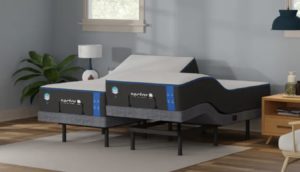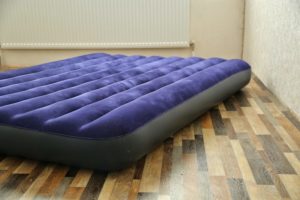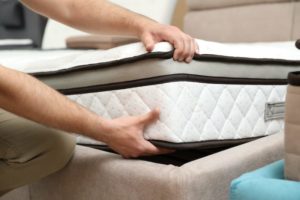What Is a Hybrid Mattress?
- A hybrid mattress consists of a foam comfort system on top of an innerspring support core. They combine the pressure-relieving capabilities of foam and the responsiveness of innerspring models. A wide range of materials and construction allow these types of mattresses to meet the needs of many sleeper types.
A hybrid mattress blends the conformity of all-foam construction with the bounce and breathability of innerspring mattresses. Hybrid models feature a coil support system beneath a comfort system made of foam, latex, or polyfoam. The comfort system is typically at least 3 inches thick.
Hybrids offer sleepers a contouring surface for pressure relief, responsiveness for ease of movement, and firmer edge support, making it a popular choice for a wide range of sleep styles.
We’ll examine the construction, materials, and performance of hybrid mattresses as well as which sleeper types benefit from these models. We’ll also look at the cost, lifespan, and pros and cons of hybrid mattresses so you can determine the best option for your needs.
Hybrid Mattress Construction
A hybrid mattress is constructed with a foam comfort system layered over an innerspring support core. Its comfort layer can be made with memory foam, latex, polyfoam, microcoils, or a combination of these materials.
An innerspring support core consists of metal coils that vary in type, thickness, and number, which affects its overall feel and performance. In hybrid mattresses, these are often pocketed coils, which help improve motion isolation. Hybrid mattresses often incorporate different size coils in the support core for zoned support and a reinforced perimeter.
Some manufacturers use the term hybrid to describe all-foam beds that incorporate both latex and memory foam layers. However, these beds are not technically hybrids because they do not contain an innerspring core.
Let us help you find the perfect bed
Answer a few questions to find the right mattress for your unique needs
Types of Hybrid Mattresses
A hybrid’s performance varies depending on its materials and construction. For example, the comfort layer may contain any of the following:
- Memory foam: Memory foam contours to the body and relieves pressure from sensitive areas.
- Polyfoam: Polyfoam moderately conforms to the sleeper and provides a firmer sleep surface than memory foam.
- Latex: Latex offers sleepers a more responsive feel while still contouring to the body.
- Microcoils: Microcoils are tiny metal coils beneath the top comfort layer that provide enhanced breathability and support.
Typically, the support core of a hybrid mattress is made of pocketed coils, sometimes called Marshall coils. These are coils wrapped individually in fabric that move independently of each other. As a result, pocketed coils respond to shifting weight without transferring motion to other coils, making it less likely for sleepers to disturb their partner when they move or get in and out of bed.
Other less common coil types shoppers may see in hybrid beds include:
- Bonnell coils: Bonnell coils are hourglass-shaped coils that are interconnected and move as a unit.
- Offset coils: Offset coils are similar to Bonnell coils but are modified for more motion isolation.
- Continuous coils: Continuous coils are rows of coils formed with a single wire that offers durable support but allows for more motion transfer.
Hybrid vs. Foam vs. Innerspring Mattress
The comfort layer of a hybrid mattress resembles that of an all-foam bed, using similar materials that contour to the sleeper’s body. However, a hybrid bed has a slightly responsive feel and firmer edge support, thanks to its coil support core. The sturdy core makes it easier to move across the bed and allows sleepers to use the entire surface.
All-foam construction uses high-density polyfoam in the support core. As a result, all-foam beds typically lack the edge support and responsiveness often preferred by couples and active sleepers.
An innerspring mattress is much bouncier than other bed types because it doesn’t have a separate comfort system. It lacks the pressure relief and motion isolation that hybrid and all-foam mattresses provide.
How Much Does a Hybrid Mattress Cost?
A queen size hybrid mattress typically costs between $1,200 and $3,000, although there are some hybrid beds priced outside of this range. The hybrid’s price-point tends to be closer to the cost of latex beds rather than foam and innerspring models.
That said, the cost of a hybrid mattress varies more than other types of beds because of its materials and construction. Factors such as the thickness of its comfort layer, type of foam used, and size and number of coils help determine the price tag. Special cooling technology, natural or organic materials, and the manufacturing location also come into play.
How Long Does a Hybrid Mattress Last?
Most hybrid mattresses typically have a lifespan of six to eight years. Hybrids designed with quality materials tend to last longer with proper care. Models with a thicker comfort system and firmer foam may be more durable than those with a thin, soft comfort layer. Additionally, hybrids usually last longer than innerspring mattresses and have a similar lifespan to foam beds.
A mattress’ usage can affect its performance over time. The combined weight of a couple puts more pressure on the bed’s structure than a single sleeper. Covering a mattress with a mattress protector or encasement can help shield it from damage.
How to Choose a Hybrid Mattress
Choosing a mattress is a personal decision that must align with each individual’s needs and preferences. However, to make a well-informed decision, it’s important to consider factors like body type, sleep position, and budget. We take a closer look at these factors so you can determine which hybrid mattress is right for you.
Body Type
Each hybrid mattress will feel and perform differently for sleepers based on their body type and weight category. What is comfortable for one sleeper may be uncomfortable for someone with a different body type. We use three categories for describing body type:
- People under 130 pounds: Sleepers in this group often need a softer comfort layer for optimal pressure relief.
- People between 130 and 230 pounds: Sleepers in this category often prefer a balance of contouring and support.
- People over 230 pounds: Sleepers in this group tend to sink further into the mattress and usually require additional support from a firm sleep surface and a coil support core.
Sleeping Position
Your primary sleep position is the one you spend the most time in at night. Each sleeper type requires varying levels of support to maintain spinal alignment and cushion pressure points. Body type and personal preferences also play a role in determining which mattress type is best for each individual sleeper.
- Side sleepers: Side sleepers usually need a thicker comfort layer that provides moderate contouring to cushion the hips and shoulders. A firmer sleep surface may not adequately relieve pressure points. Side sleepers also benefit from the pushback and responsiveness of a coil support core, which helps keep the spine in alignment.
- Back sleepers: To maintain neutral spine alignment, back sleepers need a mattress that conforms to the lower back while preventing excessive sinkage of the hips and shoulders. An overly soft memory foam comfort layer may not provide the support a back sleeper needs. A hybrid with zoned coils can help provide additional support to the lumbar region.
- Stomach sleepers: Stomach sleepers require a firmer surface and may find memory foam comfort layers too soft. Latex and polyfoam comfort layers better support stomach sleepers, as they help promote spinal alignment.
“Back and stomach sleepers may benefit from a firmer mattress, as extra support can feel more comfortable in these positions. Side sleepers may prefer a mattress that has softness. It’s also important for side sleepers to find an option that ensures the head and neck are in alignment. Whatever is the most comfortable for you to sleep with is worth the investment.”
– Sarah Silverman, Psy.D., a licensed psychologist and holistic sleep wellness consultant who treats patients in New York and Florida.
Firmness
We rate mattress firmness levels using a 10-point firmness scale, where 1 is extra soft and 10 is extra firm. Your body type and sleep position affects how much you sink into the mattress and how firm it feels. For example, a side sleeper under 130 pounds may find a medium mattress doesn’t adequately cushion pressure points, and a stomach sleeper over 230 pounds may find a medium firm model permits too much sinkage.
Body Pain
People experiencing body pain may find that a hybrid mattress’ balance of contouring and support can help ease their discomfort. With a wide range of hybrid options on the market, those who experience neck, back, or hip pain may find the different materials and firmness levels make it easier to find a bed that suits their individual needs.
For example, the pocketed coils found in many hybrid mattresses are designed to support each part of the body as they individually respond to pressure. Zoned support cores offer more support to certain areas of the body, which can also help relieve aches and pain.
Budget
Since a mattress is a significant investment, it’s important to carefully consider your sleep needs when determining your budget for a new one. The price-point of a hybrid mattress tends to cost more than other mattress types, but there are models available across all price ranges. Many manufacturers offer sales and discounts to accommodate value shoppers as well.
Should You Consider a Hybrid Mattress?
You may want to consider a hybrid mattress if you enjoy the conformity of foam but want the bounce and support of an innerspring model. Couples and active sleepers often prefer a hybrid bed for its ease of movement and edge support. Sleepers who overheat in all-foam beds may appreciate the increased airflow of a hybrid’s coil support core.
However, hot sleepers should keep in mind that a memory foam hybrid may still be too warm. In contrast, a latex hybrid traps less body heat and offers more temperature regulation. This type of mattress is more expensive, as are hybrid beds in general, so shoppers may need to shop around to find one within their budget.
| Pros | Cons |
|---|---|
|
|

Still have questions? Ask our community!
Join our Sleep Care Community — a trusted hub of sleep health professionals, product specialists, and people just like you. Whether you need expert sleep advice for your insomnia or you’re searching for the perfect mattress, we’ve got you covered. Get personalized guidance from the experts who know sleep best.









